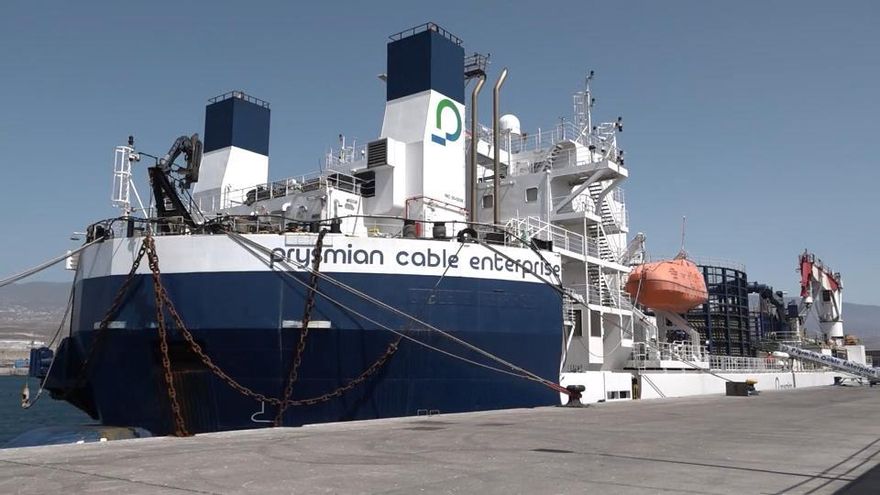
The vessel Cable Enterprise has docked at Granadilla port to finalise preparations for the laying of the submarine power cable that will connect Tenerife and La Gomera. Red Eléctrica, a company of Redeia responsible for the operation and transportation of the electrical system, is completing work to commence installation before the end of this month, which is expected to be finished by the end of this year.
This tripolar alternating current cable is the deepest in the world, forming a double-circuit underground-submarine line at 66 kilovolts (kV) –with a transport capacity of 50 megavolt-amperes (MVA) per circuit. It includes a submarine stretch of approximately 36 kilometres in length, reaching a maximum depth of 1,145 metres, along with two land sections on La Gomera and Tenerife.
For this operation, Red Eléctrica employs one of the most advanced ships available. The Cable Enterprise is part of Prysmian’s fleet, a global leader in the manufacturing, supply, and design of cables. Designed to maintain stability and autonomy in adverse weather conditions, it simultaneously carries out cable laying and burial, supporting up to 180 tonnes.
The councillor for Ecological Transition and Energy of the Canary Government, Mariano H. Zapata, who visited the ship yesterday, described these works as “a global milestone and pivotal for the energy planning of the Archipelago.” He stated that the development of this cutting-edge facility “is part of the government’s energy strategy, aimed at securing supply in the islands through various measures, such as interconnection,” which, he noted, will allow Canary Islands “to further advance towards a greater penetration of renewable energies and meet our decarbonisation goals.”
Hernández Zapata emphasised that this strategic project, which has the highest guarantees of environmental care, results from the collaborative efforts of the involved administrations and companies and “the impetus from the Canary Government and this ministry to expedite this installation, thereby providing enhanced energy security for La Gomera.” He explained that “the laying of this cable complements ongoing work at the El Palmar (San Sebastián de La Gomera) and Chío (Guía de Isora) substations, infrastructures that will complete this interconnection.”
Ainara Irigoyen, Redeia’s representative in the Canary Islands, argued that the submarine electrical interconnection between the two islands “represents a significant advance in the energy transition, as it will provide greater quality and reliability of energy supply, alongside increased efficiency and decarbonisation in the electrical systems of Tenerife and La Gomera.” Irigoyen noted that this submarine laying is a remarkable technological challenge due to the distance of 36 kilometres and the depth of 1,145 metres below sea level.
Collaboration Exercise
Joining the visit to the Cable Enterprise was the second vice president and councillor of the Presidency of the Cabildo of Tenerife, José Miguel Ruano, who stated that this collaboration “reinforces the mutual commitment between the islands to modernise and enhance electrical connectivity, which particularly benefits the island of La Gomera in securing its electricity supply.” In this regard, Ruano reminded that the island corporation “continues to be committed, in collaboration with other entities, to strengthening energy generation in Tenerife through emergency measures that are already underway to create a robust system that meets the needs of the inhabitants.”
Representing the Port Authority of Santa Cruz de Tenerife, its deputy director, Airam Díaz, highlighted that “it is a primary function of our ports to support the diversification of services in our community and its positive impact on the Canary economy.” From this perspective, “hosting this ship at Granadilla port is essential for consolidating this dock as a logistical and technical support for such operations in the strategic field of energy.”
Completing the delegation were the mayor of Guía de Isora, Ana Dorta; the acting mayor of Granadilla de Abona, Marcos Antonio Rodríguez Santana; and the project director, Pablo García Celaá.
With this submarine connection, La Gomera will be able to generate and integrate renewable energy beyond the total energy demand of the island, reducing its dependence on the El Palmar thermal power plant and improving the quality of supply. Furthermore, the Tenerife system will be able to incorporate the excess renewable generation from La Gomera, decreasing fossil fuel use and helping to lower greenhouse gas emissions.
Two Years Since the First Stone
The Redeia Group is investing €114 million in a project that officially began on 20 March 2023.
With a length of 42 kilometres, the cable, which incorporates integrated fibre optics, will traverse over six kilometres underground and another 36 underwater, reaching a record depth of 1,145 metres. Each metre of cable weighs about 50 kilos, translating to approximately 50,000 kilos per kilometre, summing to more than 1,800 tonnes in total.
On that 20 March 2023, a groundbreaking engineering project commenced, according to the authorities present at the ceremonial laying of the first stone, with Ángel Víctor Torres serving as president of the Canary Islands.
















